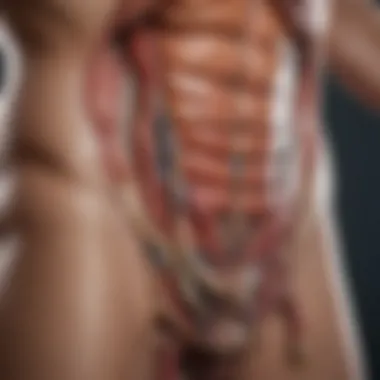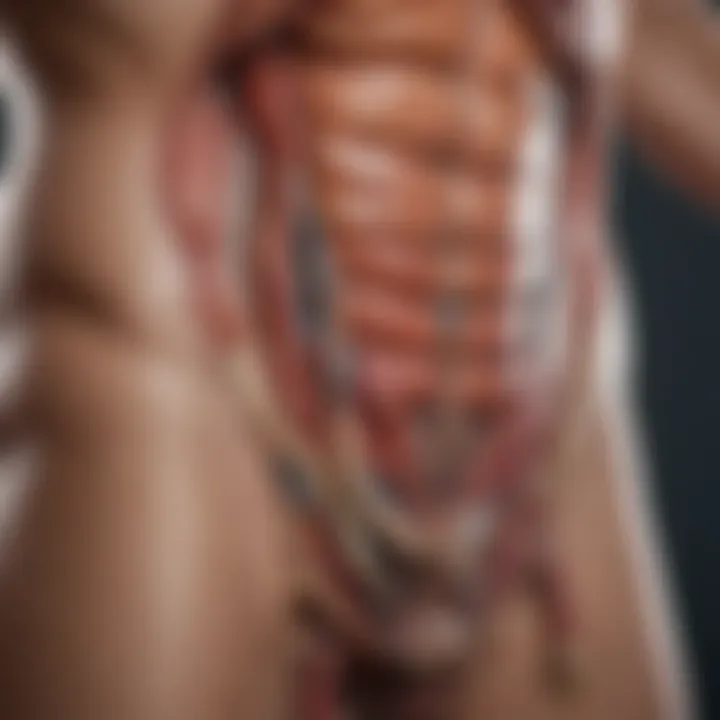Understanding Pain in the Lower Right Abdomen


Intro
Pain in the lower right abdomen can be a significant concern, often raising alarms about underlying conditions. The abdominal area is complex, home to various vital organs, each potentially associated with distinct forms of pain. Understanding the causes, diagnostic methods, and treatment options for lower right abdominal pain is essential for both patients and practitioners.
This pain might emerge from numerous origins, ranging from musculoskeletal issues to gastrointestinal complications. With its variance, the need for accurate diagnosis becomes critical to avoid mismanagement and promote effective treatment. Readers should be equipped with an understanding of these complexities and the significance of seeking adequate medical advice when faced with such discomfort.
Research Overview
Methodological Approaches
To comprehend the causes of lower right abdominal pain, a multi-faceted approach is required. Researchers often employ various methodologies that include clinical studies, case reports, and systematic reviews. These approaches help gather data about different conditions that may manifest as pain in this area. For instance, research on appendicitis, one of the most common causes, offers insights into symptoms, progression, and differential diagnosis.
Moreover, imaging techniques like ultrasound and MRI play a pivotal role in confirming diagnoses. Ultrasound is frequently the first step in assessing pain in this quadrant due to its non-invasive nature. Studies show that it helps in identifying conditions like ovarian cysts or hernia.
Significance and Implications
The implications of understanding the pain in the lower right abdomen extend beyond individual cases. With appropriate research and knowledge, medical professionals can enhance patient care, improve diagnostic accuracy, and streamline treatment plans. This specific focus contributes to reducing emergency room visits for misdiagnosed conditions. An educated approach to abdominal pain can lead to early interventions, possible avoidance of surgical procedures, and ultimately, better patient outcomes.
Current Trends in Science
Innovative Techniques and Tools
Medical science is advancing swiftly, bringing forth innovative tools that aid in diagnosing abdominal pain more effectively. For instance, endoscopy has transformed the examination of gastrointestinal issues. In addition, smartphone applications are being developed to assist patients in tracking symptoms and providing preliminary analyses before medical consultation. These advancements can facilitate quicker diagnosis in clinical settings and promote proactive health management.
Interdisciplinary Connections
Research on abdominal pain often involves collaboration across disciplines, including gastroenterology, gynecology, and radiology. This interdisciplinary effort ensures that patients receive comprehensive evaluations, as many conditions overlapping in symptoms may require input from various specialists. Combined expertise fosters better understanding and equips healthcare providers with diverse perspectives essential for optimal patient care.
Prelims to Abdominal Pain
Abdominal pain is a common complaint that can arise from various underlying issues. Understanding the intricacies of abdominal pain is crucial for effective diagnosis and treatment. This section serves as a foundation, helping readers navigate the complexities involved in recognizing and evaluating abdominal pain, particularly in the lower right quadrant.
Many factors can contribute to abdominal pain, including lifestyle choices, dietary habits, and existing health conditions. Learning about these factors can empower individuals to seek appropriate medical attention and potentially mitigate complications.
Moreover, awareness of abdominal pain is not just about identification. It involves understanding the implications of the pain, potential causes, and effective responses. This information can significantly influence outcomes and lead to better health management strategies.
Defining Abdominal Pain
Abdominal pain refers to discomfort that originates from the organs within the abdomen. This includes organs like the stomach, intestines, liver, pancreas, and kidneys. The pain can vary in intensity, location, and duration, which can provide important clues about its origin.
There are two primary types of abdominal pain:
- Acute Pain: Sudden onset, often intense, indicating a potential serious condition.
- Chronic Pain: Longer-lasting discomfort that may signify ongoing health issues.
Each type requires a different approach to evaluation and management, making it essential to provide clear definitions and context.
Anatomy of the Abdomen
The abdomen is divided into four regions: upper left, upper right, lower left, and lower right. Each region contains specific organs, which play distinct roles in digestion and other bodily functions. Understanding this anatomy is key to accurately identifying pain.
In the lower right quadrant, several critical structures include:
- Appendix: A small tube connected to the intestine and often relates to appendicitis.
- Ovaries and Fallopian Tubes (in females): Can be involved in conditions like ovarian cysts.
- Colon: Includes parts of the large intestine, where various gastrointestinal disorders can manifest.
- Pelvic Organs: These may contribute to pain, especially in females.
Recognizing the anatomy of the lower right abdomen aids in pinpointing potential causes of pain and informs diagnostic processes.
Anatomy of the Lower Right Abdomen
Understanding the anatomy of the lower right abdomen is crucial for diagnosing and treating various medical conditions that may present with pain in this area. Comprehending the specific structures and their functions helps clinicians pinpoint the source of discomfort and plan appropriate interventions. This section delves into the key anatomical aspects that underpin the clinical manifestations of lower right abdominal pain.
Structures Involved
The lower right abdomen houses several vital structures. These include the cecum, appendix, parts of the small intestine such as the ileum, right ovary in females, and various blood vessels and nerves that supply these organs. The cecum forms the beginning of the large intestine, and its proximity to the appendix makes it a frequent site of inflammation in appendicitis. An understanding of these structures is necessary for identifying conditions that cause pain:
- Cecum: The pouch-like structure that receives material from the small intestine.
- Appendix: A small, tube-like organ attached to the cecum which can become inflamed.
- Ileum: The final part of the small intestine where absorption of nutrients occurs.
- Ovary: In females, situated in the lower right quadrant; related conditions include ovarian cysts and ectopic pregnancies.
- Blood Vessels: Major blood vessels, including the iliac arteries and veins, provide circulation to these organs.
- Nerves: Including the ilioinguinal and genitofemoral nerves contribute to sensation in this region.


Each structure plays a unique role in the functioning of the abdomen, which highlights their significance in both health and disease.
Function of the Lower Right Quadrant
The lower right quadrant of the abdomen serves several essential functions. It is involved in digestion, absorption, and reproductive processes. Key functions include:
- Digestion and Absorption: The cecum and ileum work collectively to process undigested food from the small intestine. Nutrients are absorbed here for the body's use.
- Reproductive Health: The right ovary plays a role in hormone production and the release of eggs, impacting female reproductive health.
- Waste management: The connection of the cecum to the large intestine is vital for waste accumulation before elimination.
In summary, this quadrant plays significant roles not only in digestive functions but also in reproductive health. Knowledge of these functions can guide the healthcare provider in determining potential causes of pain effectively.
Understanding the anatomical structures and their functions is fundamental in evaluating abdominal pain conditions and leading to timely diagnosis.
This understanding of the anatomical layout in the lower right abdomen provides invaluable insight into possible pathological processes that can cause pain, further facilitating effective medical evaluation and treatment.
Causes of Pain in the Lower Right Abdomen
Understanding the various causes of pain in the lower right abdomen is crucial for students, researchers, educators, and professionals. This section offers insight into specific conditions that lead to discomfort in this area. Identifying the source is essential as it can direct the course of treatment and management. Conditions range from common issues like appendicitis to less frequent problems such as ovarian cysts. Each cause possesses unique characteristics requiring tailored approaches for diagnosis and management.
Appendicitis
Appendicitis is one of the most prevalent causes of lower right abdominal pain. It occurs when the appendix becomes inflamed, often due to obstructions that trap bacteria. Typical symptoms include sudden pain near the belly button, which then shifts to the lower right abdomen. Other symptoms might include fever and nausea. The importance of recognizing appendicitis lies in its potential for serious complications if not treated promptly. A perforated appendix can lead to peritonitis, an emergency situation that necessitates surgical intervention. Early diagnosis made through methods like clinical examination and imaging is vital in preventing complications.
Ovarian Issues
In women, pain in the lower right abdomen may arise from ovarian issues. Conditions such as ovarian cysts or torsion can cause significant pain. Cysts are fluid-filled sacs that can form on the ovaries. They may rupture, leading to sharp pain and internal bleeding. On the other hand, ovarian torsion refers to the twisting of the ovary, cutting off its blood supply. Symptoms can include severe sudden pain, swelling, and sometimes vomiting. The significance of understanding ovarian conditions cannot be understated, as some scenarios may demand immediate surgical attention to preserve ovarian health.
Gastrointestinal Pathologies
Gastrointestinal issues also contribute to pain in the lower right abdomen. Conditions like Crohn’s disease or diverticulitis can encompass this area. Crohn’s disease is an inflammatory bowel disease, causing inflammation that may manifest as abdominal pain. Diverticulitis occurs when small pouches in the colon become inflamed. Symptoms often present as cramping pain, changes in bowel habits, and even fever. Recognizing these gastrointestinal pathologies is essential for those involved in health care and research. This understanding can lead to appropriate treatments such as medication or dietary changes.
Musculoskeletal Factors
Musculoskeletal problems can also lead to discomfort in the lower right abdomen. Conditions such as hernias or muscle strains frequently result in localized pain. A hernia may occur when fatty tissue or part of the intestine protrudes through a weak spot in abdominal muscles. This can cause noticeable bulges and discomfort, especially during physical activity. Muscle strains, on the other hand, can arise from overexertion or improper lifting. Patients may experience varying levels of pain, often linked to specific movements. Recognizing the potential for musculoskeletal causes is important in providing a comprehensive assessment of abdominal pain.
Symptoms Accompanying Lower Right Abdominal Pain
Understanding the symptoms that come with pain in the lower right abdomen is crucial in forming a comprehensive view of potential underlying conditions. These accompanying symptoms aid both patients and healthcare providers in discerning the nature and urgency of the situation.
Each symptom can signify different health issues, from benign to more serious conditions. In this section, we will discuss three critical symptoms: nausea and vomiting, changes in bowel movements, along with fever and inflammation. Recognizing these symptoms and the context they present can be essential for timely diagnosis and treatment.
Nausea and Vomiting
Nausea and vomiting often accompany lower right abdominal pain. These symptoms can indicate any number of possible conditions, including gastrointestinal disturbances or infection. Understanding how they relate to abdominal pain is significant because they can signal more severe events such as appendicitis or ectopic pregnancy.
In cases of appendicitis, for example, nausea can precede the onset of pain, creating confusion about the source of discomfort. This relationship is why healthcare professionals take a thorough patient history, often investigating the timeline of symptoms. Treatment for nausea and vomiting may initially focus on hydration and alleviating discomfort prior to determining the underlying cause.
Changes in Bowel Movements
Alterations in bowel habits, whether diarrhea or constipation, may reveal important clues about gastrointestinal health. These changes can accompany pain in the lower right abdomen due to conditions like irritable bowel syndrome, infectious gastroenteritis, or obstructions.
Patients experiencing significant changes in bowel movements alongside abdominal pain should inform their doctors. A stool sample might be needed for testing to narrow down potential sources. Attention to the consistency and frequency of bowel movements can lead to more accurate diagnostics. Since the digestive system is interconnected, changes can point to issues that may need immediate intervention.
Fever and Inflammation
Fever is another key symptom that may accompany lower right abdominal pain. An elevated temperature often signifies an underlying infection or inflammation. When associated with lower abdominal pain, these symptoms can point towards conditions like appendicitis or ovarian cysts.
Healthcare professionals often use a physical examination and diagnostic tests to assess for signs of inflammation. This combination of information—pain, fever, and physical examination results—can inform the level of urgency required for treatment. Timely diagnosis is necessary to mitigate complications that may arise from untreated conditions.
Recognizing these accompanying symptoms forms an integral part of assessing lower right abdominal pain. Patients should be aware of their symptoms and provide detailed reports to healthcare providers.
In summary, symptoms such as nausea, changes in bowel movements, and fever, are intertwined with lower right abdominal pain and essential in guiding diagnosis and treatment. Understanding these elements enhances a person's ability to articulate their experience to healthcare providers, resulting in more effective management.
Diagnostic Approaches for Abdominal Pain
Accurate diagnosis of pain in the lower right abdomen is critical. Identifying the underlying cause influences treatment decisions and patient outcomes. The diagnostic process often combines various approaches to achieve a comprehensive understanding. Clinical examination and diagnostic imaging are primary methods employed. Laboratory testing also plays a significant role. Careful assessment and analysis ensure a targeted plan for the patient.
Clinical Examination


During a clinical examination, a healthcare provider evaluates the patient's physical condition. This involves checking for tenderness, swelling, or rigidity in the abdomen. The examiner often asks about symptom history, which provides crucial insights into potential pathologies. For example, sudden pain might suggest appendicitis. Meanwhile, more chronic pain could point to gastrointestinal or muscular issues.
Clinical examination is often the first step in understanding pain in the lower right abdomen, laying the groundwork for further diagnostic efforts.
This investigative phase identifies red flags that warrant immediate attention. Additionally, the clinician assesses vital signs, such as temperature and heart rate. Changes in these markers can indicate infection or inflammation, guiding the next steps.
Imaging Techniques
Imaging techniques are invaluable in diagnosing abdominal pain. They provide visual insights into underlying structures. Common imaging methods include ultrasound, CT scans, and MRI scans.
Ultrasound
Ultrasound uses sound waves to create images of abdominal organs. It is non-invasive and does not utilize radiation, making it a popular initial diagnostic tool. One key characteristic of ultrasound is its ability to detect abnormalities such as fluid collections and organ enlargement. Notably, it is especially useful for visualizing the appendix and ovaries.
However, ultrasound has some limitations; it may not provide detailed views of deep structures and is sometimes operator-dependent. Yet, its speed and safety make it a favored choice in emergency settings.
CT Scans
CT scans deliver detailed cross-sectional images of the abdomen. They use X-rays and computer technology to create comprehensive views. A significant advantage of CT scans is their ability to accurately diagnose conditions like appendicitis, diverticulitis, or tumors.
The high-resolution images allow for a thorough analysis of the abdominal cavity and surrounding structures. However, concerns regarding radiation exposure exist, especially for repeated imaging. Still, when used judiciously, CT scans are highly effective in evaluating acute conditions.
MRI Scans
MRI scans employ magnetic fields and radio waves to produce detailed images of internal organs. They are particularly effective for soft tissue evaluation, including reproductive organs. The primary characteristic of MRI is its ability to differentiate tissues effectively without radiation, which is a major advantage in certain clinical scenarios.
However, MRI is typically more expensive and time-consuming than the other imaging techniques. Additionally, some patients may find it uncomfortable due to the enclosed space of the scanner. MRI plays a supportive role, often reserved for complex cases requiring detailed anatomical information.
Laboratory Testing
Laboratory testing supports the diagnostic process by providing objective data. Blood tests and urinalysis are standard procedures that aid in the evaluation of abdominal pain.
Blood Test
A blood test can reveal many important factors. It assesses infection indicators such as white blood cell count or inflammatory markers like C-reactive protein. This data is essential to identify conditions requiring urgent intervention. For instance, an elevated white blood cell count can suggest appendicitis or other infections.
Blood tests are quick and can guide clinical decisions efficiently. However, they do not replace imaging or thorough examination but complement those methods.
Urinalysis
Urinalysis examines the content and characteristics of urine. It helps identify urinary tract infections or kidney issues, which may manifest as lower abdominal pain. For patients where a urinary issue is suspected, urinalysis becomes crucial. By assessing color, clarity, and presence of substances like glucose or protein, relevant diagnostics can be achieved.
Although urinalysis is minimally invasive and cost-effective, its results require careful interpretation, often in conjunction with other diagnostic methods.
Overall, the integration of clinical examination, imaging techniques, and laboratory testing establishes a comprehensive approach to understanding lower right abdominal pain.
Management of Lower Right Abdominal Pain
Management of lower right abdominal pain is a significant aspect of understanding and addressing the complexities involved with such discomfort. Recognizing that not all abdominal pain is the same is crucial. Pain can stem from a variety of causes such as appendicitis, ovarian issues, and musculoskeletal factors. Thus, a tailored approach is essential for effective management. This section will discuss the initial treatment strategies, surgical interventions, and non-surgical options that cater to different underlying conditions, emphasizing the importance of a comprehensive evaluation when formulating a management plan.
Initial Treatment Strategies
Initial treatment strategies are vital in alleviating lower right abdominal pain while the underlying cause is determined. Managing symptoms can significantly improve a patient’s comfort and health. Some common initial strategies include:
- Pain Management: Using over-the-counter medications like ibuprofen or acetaminophen can provide immediate relief. This helps in controlling discomfort until a diagnosis is made.
- Date of Onset and Symptom Assessment: It's important to track when the pain began and any accompanying symptoms. This information is crucial for healthcare providers to understand the severity and potential causes.
- Rest and Observation: In some cases, a short period of rest along with monitoring symptoms can help. This allows for any potential changes in pain, which might indicate the need for advanced interventions.
These strategies primarily aim to stabilize the patient and create a baseline understanding of the pain's origin.
Surgical Interventions
Surgical interventions may be necessary if the underlying condition poses immediate risks. This section will focus on two major types of surgical procedures often utilized in the management of lower right abdominal pain: appendectomy and ovarian surgery.
Appendectomy
An appendectomy involves the surgical removal of the appendix. This procedure is commonly performed when appendicitis is diagnosed. Its contribution to managing lower right abdominal pain is critical because untreated appendicitis can lead to severe complications.


The key characteristic of appendectomy is its effectiveness. By removing the inflamed appendix, the potential for further complications is eliminated. This makes it a well-regarded option in urgent situations. The unique feature of this surgery is the relatively short recovery time compared to other major surgeries, allowing patients to return to normal activities fairly quickly. However, disadvantages may include post-surgical pain and the risk of infection.
Ovarian Surgery
Ovarian surgery refers to various procedures that address issues related to the ovaries, such as cysts or tumors. This type of surgery is performed when conditions affecting the ovaries lead to significant discomfort or health risks.
The key characteristic of ovarian surgery is its ability to directly resolve issues that can be contributing factors to lower right abdominal pain. This often results in significant and lasting relief for patients. A unique feature of ovarian surgery is the variety of approaches available, including laparoscopic techniques which minimize recovery time. However, some disadvantages could include potential hormonal changes and the risk of complications associated with surgery.
Non-Surgical Treatment Options
Non-surgical treatment options are essential components of managing lower right abdominal pain, especially when surgeries are not indicated or after surgical interventions. This section discusses two significant non-surgical approaches: medication for pain relief and physical therapy.
Medication for Pain Relief
Medication for pain relief plays a crucial role in managing discomfort without invasive procedures. Non-steroidal anti-inflammatory drugs (NSAIDs) such as naproxen and acetaminophen can significantly reduce pain. The key characteristic of using medication is its immediate availability and effectiveness, allowing patients to manage their symptoms as needed.
The unique feature of medication for pain relief is its flexibility. Dosing can often be adjusted based on the severity of pain. However, some disadvantages include potential side effects, such as gastrointestinal issues or reliance on medication, which can be problematic in the long run.
Physical Therapy
Physical therapy can be an integral part of rehabilitation for those experiencing persistent pain. This approach often includes specific exercises aimed at strengthening abdominal muscles and improving flexibility. The key characteristic of physical therapy is its holistic approach. It addresses not only the pain but also the overall function of the body.
The unique feature of physical therapy is that it promotes long-term wellness and can reduce the risk of future issues. However, some disadvantages may include time commitment and the need for patient engagement to achieve optimal results.
Understanding the management of lower right abdominal pain requires a nuanced approach, recognizing that each patient’s situation is unique. Deliberation on treatment options can enhance the effectiveness of the overall management plan.
Long-Term Considerations
Long-term considerations play a pivotal role in understanding and managing pain in the lower right abdomen. Chronic pain conditions can lead to a significant reduction in quality of life. It is essential to recognize the potential for ongoing issues that might arise after an initial diagnosis. Awareness of these considerations can aid both patients and healthcare providers in developing effective management strategies.
Understanding chronic conditions requires that individuals recognize the nature of their symptoms. Some abdominal pains may emerge from perpetual sources, like irritable bowel syndrome or chronic appendicitis. These conditions generally necessitate ongoing evaluation and treatment, including lifestyle changes and possibly medication. This awareness empowers individuals to take charge of their health.
Understanding Chronic Conditions
Chronic conditions affecting the lower right abdomen may not be easy to diagnose. They can, however, develop over time and result in persistent discomfort. Conditions like Crohn's disease or endometriosis may cause recurrent pain. These issues often require multidisciplinary approaches, combining dietary modifications, medical therapy, and regular follow-up with healthcare professionals. In contrast to acute conditions, chronic issues necessitate a sustained commitment to management.
Preventative Measures
Preventing future abdominal pain is fundamental for maintaining long-term health. Key components include dietary changes and lifestyle adjustments. These measures can mitigate the risk of recurrent issues and improve overall well-being.
Dietary Changes
Dietary changes significantly contribute to managing abdominal pain. A well-balanced diet can alleviate symptoms associated with digestive disorders. Integrating high-fiber foods helps maintain regular bowel movements, reducing the risk of constipation, which can aggravate lower right abdominal pain. This approach also decreases inflammation in the body.
Key characteristics of dietary changes include an emphasis on whole foods, such as fruits, vegetables, and whole grains. These elements make it a beneficial choice for individuals with chronic abdominal pain. However, it is crucial to consider that changes in diet should be tailored to individual needs, and sudden modifications can lead to temporary discomfort. Evaluating and adapting dietary habits can provide significant advantages in managing chronic conditions.
Lifestyle Adjustments
Lifestyle adjustments also play a critical role in pain management. Regular exercise promotes better digestion and can enhance overall abdominal health. Techniques such as yoga or pilates may target specific abdominal muscles, improving strength and flexibility. This characteristic makes lifestyle adjustments valuable for preventing long-term pain in the lower right abdomen.
A unique feature of these changes is their adaptability. Individuals can adjust these practices as needed to suit their personal preferences and circumstances. The primary advantage of lifestyle adjustments is their potential for lasting benefits without the need for invasive treatments. However, some may find consistent exercise challenging. Establishing a routine that is engaging rather than daunting is crucial for success.
Recognizing and implementing long-term considerations allows individuals to take proactive steps toward managing lower right abdominal pain effectively.
Culmination
In this article, we have delved into the various elements surrounding pain in the lower right abdomen. Understanding this topic is pivotal due to the multitude of potential causes ranging from minor issues to serious conditions like appendicitis or ovarian complications. By comprehensively reviewing symptoms, diagnostic techniques, and management options, readers gain insight into the critical nature of abdominal pain.
A coherent grasp of the symptoms and underlying causes allows individuals to make informed decisions about seeking medical assistance. Abdominal pain is often a complex issue that requires a nuanced understanding of anatomy and physiology. Patients with persistent or severe pain must recognize the urgency of their situation. This knowledge can empower them to advocate for themselves during medical consultations, ultimately leading to better health outcomes.
Summary of Key Points
- Understanding the diverse causes of lower right abdominal pain can aid in early diagnosis.
- Symptoms such as nausea, vomiting, and changes in bowel movements offer critical clues.
- Diagnostic procedures like imaging and lab tests are essential for accurate assessments.
- Treatment options range from non-invasive methods to surgical interventions, based on the underlying cause.
- Chronic conditions necessitate ongoing management and lifestyle adjustments to mitigate pain.
Importance of Seeking Medical Attention
Recognizing when to seek medical assistance is crucial in managing abdominal pain. Symptoms that escalate in intensity or are accompanied by fever, persistent vomiting, or significant changes in bowel habits require prompt evaluation. Ignoring such indicators can lead to severe complications, particularly in cases of appendicitis, which can progress rapidly.
Understanding the limitations of self-diagnosis also plays a key role. Individuals may misinterpret pain signals, attributing them to inconsequential issues. This misjudgment can delay treatment, leading to adverse health effects.
"Timely medical attention can save lives. Don't wait if pain becomes severe or is combined with other alarming symptoms."
In summary, approaching abdominal pain with a well-informed perspective not only aids in early detection but also empowers patients when navigating health care systems. A proactive approach fosters better communication with healthcare providers and lays the groundwork for effective treatment plans.



